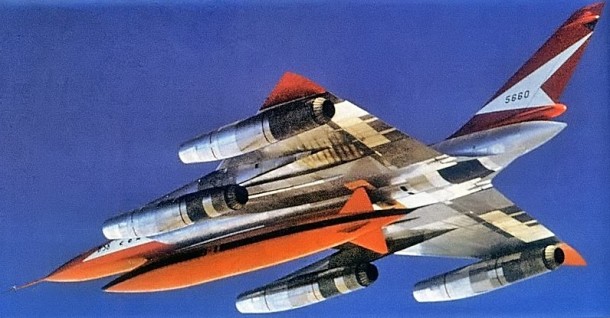
Fifty-eight years ago today, the USAF/Convair XB-58A (S/N 55-660) Hustler first attained its double-sonic design airspeed when it was flown to Mach 2.03 at an altitude of 43,250 feet. This historic achievement took place at Edwards Air Force Base on the type’s 24th test flight. The mission totaled 1 hour and 55 minutes with famed Convair test pilot Beryl Arthur Erickson at the controls.
The B-58A Hustler was the United States first supersonic-capable bomber and was originally designed for the strategic mission. The aircraft was powered by four (4) General Electric J79-GE-5A turbojets generating 62,400 lbs of sea level thrust in afterburner. Maximum take-off weight was nearly 177,000 lbs.
Convair’s stunning delta-winged bomber was 97 feet in length with a wing span of 57 feet. Wing area was roughly 1,550 square feet. Aircraft maximum height was 30 feet as measured from the ground to the top of the vertical tail.
Flight crew for the B-58A consisted of the pilot, bombadier/navigator, and defensive systems operator. The crew was arranged in tandem with each crew member seated in a separate cockpit. The type carried thermonuclear ordnance. A total of 116 B-58A aircraft were manufactured.
The Hustler’s performance was impressive then and now. It had a maximum speed of 1,400 mph and a service ceiling of 63,400 feet. The aircraft could climb in excess of 17,000 feet per minute at gross take-off weight and up to 46,000 feet per minute near minimum weight.
The B-58A had a difficult gestation due to its advanced design and demanding performance requirements. A large number of aircraft and flight crews were lost due to a variety of flight control and structural problems. First flight took place on 11 November 1956 with the type finally entering the USAF inventory on 15 March 1960.
The USAF/Convair B-58A Hustler was operational for nearly 10 years and was retired on 31 January 1970. The aircraft was never used in anger.
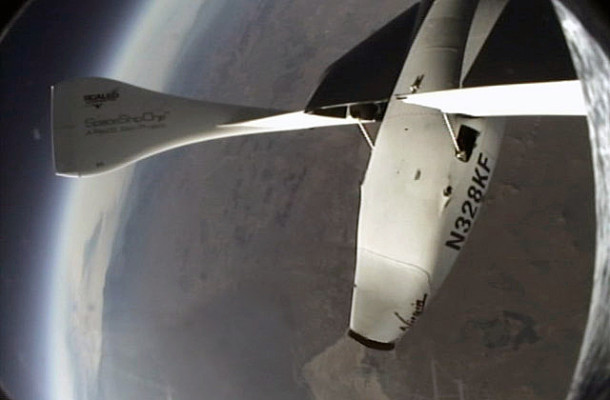
Eleven years ago this week, Scaled Composite’s SpaceShipOne flew to an altitude of 62.214 statute miles. The flight marked the first time that a privately-developed flight vehicle had flown above the 62-statute mile boundary that entitles the flight crew to FAI-certified astronaut wings. As a result, SpaceShipOne pilot Mike Melvill became history’s first private citizen astronaut.
On Monday, 21 June 2004, SpaceShipOne Mission 15P began with departure from California’s Mojave Spaceport at 0647 PDT. Carrying SpaceShipOne at the centerline station, Scaled’s White Knight aircraft climbed to the drop altitude of 47,000 feet.
At 0750 PDT, the 7,900-pound SpaceShipOne fell away from the White Knight and Melvill immediately ignited the 16,650-pound thrust hybrid rocket motor. Melvill quickly then pulled SpaceShipOne into a vertical climb.
Passing through 60,000 feet, SpaceShipOne experienced a series of uncommanded rolls as it encountered a wind shear. Melvill struggled with the controls in an attempt to arrest the roll transient. Then, late in the boost, the vehicle lost primary pitch trim control. In response, Melvill switched to the back-up system as he continued the ascent.
Rocket motor burnout occurred at 180,000 feet with SpaceShipOne traveling at 2,150 mph. It now only weighed 2,600 pounds. The vehicle then coasted to an apogee of 62.214 statute miles (328,490 feet). The target maximum altitude was 68.182 statute miles (360,000 feet). However, the control problems encountered going upstairs caused the trajectory to veer somewhat from the vertical.
Melvill experienced approximately 3.5 minutes of zero-g flight going over the top. He had some fun during this period as he released a bunch of M&M’s and watched the chocolate candy pieces float in the SpaceShipOne cabin.
Back to business now, Melvill transitioned SpaceShipOne to the high-drag feathered configuration in preparation for the critical entry phase of the mission. The vehicle initially accelerated to over 2,100 mph in the airless void before encountering the sensible atmosphere. At one point during atmospheric entry, Melvill experienced in excess of 5 g’s deceleration.
At 57,000 feet, Melvill reconfigured SpaceShipOne back to the standard aircraft configuration for powerless flight back to the Mojave Spaceport. Fortunately, the aircraft was a very good glider. The control problems encountered during the ascent resulted in atmospheric entry taking place 22 statute miles south of the targeted reentry point.
SpaceShipOne touched-down on Mojave Runway 12/30 at 0814 PDT; thus ending an historic, if not harrowing mission.
After the flight, Mike Melvill had much to say. But perhaps the following quote says it best for the rest of us who can only imagine what it was like: “And it was really an awesome sight, I mean it was like nothing I’ve ever seen before. And it blew me away, it really did. … You really do feel like you can reach out and touch the face of God, believe me.”
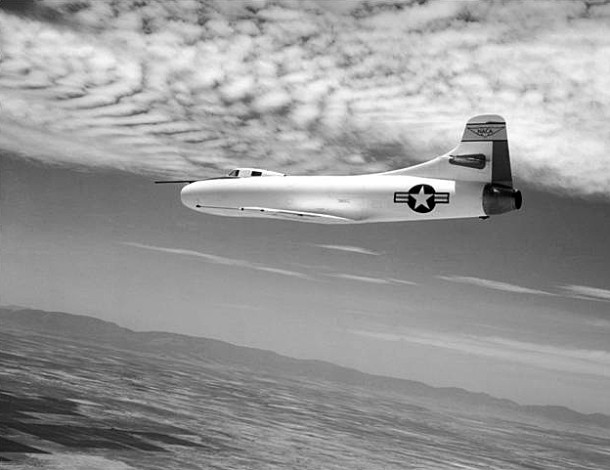
Sixty-two years ago this month, NACA test pilot A. Scott Crossfield piloted the United States Navy/Douglas D-558-I Skystreak transonic research aircraft on the last of 230 flights. The type’s final test flight was flown on Wednesday, 10 June 1953 at Edwards Air Force Base, California.
Flight near and beyond the speed of sound is characterized by large variations in flowfield density. Variable density flow is known as compressible flow. A key compressible flow phenomenon is the formation of shock waves which result when the supersonic freestream is deflected or turned by the presence of the aircraft.
As every aircraft has a distinct shape, it also has its own distinct shock wave system. The topology and strength of this 3-dimensional shock wave system significantly affects aircraft flight performance, stability and control, handling qualities, airframe buffet characteristics and airloads.
Following World War II, the United States initiated a sustained flight research effort in the realm of transonic and supersonic flight. In league with the US military and the National Advisory Committee For Aeronautics (NACA), the American aeronautical industry designed and built a variety of aircraft used to conduct flight research during the 1940’s and 1950’s. These experimental aircraft were the first of the fabled X-planes.
In June of 1945, the Douglas Aircraft Company was awarded a contract by the United States Navy (USN) to build a total of six (6) flight research aircraft. These vehicles would be used in a two phase flight research program. Phase I was devoted to transonic flight testing while Phase II would investigate supersonic flight. The Phase I aircraft was known as the D-558-I Skystreak while the Phase II airplane was called the D-558-II Skyrocket.
The USN/Douglas D-558-I Skystreak measured 36-feet in length and had a wingspan of 25-feet. The straight-winged aircraft weighed a bit over 10,000 pounds and was powered by an Allison J35 turbojet rated at 5,000 pounds of sea level thrust. The aircraft was single place and employed ground take-off. Three (3) copies were made; BuAer tail numbers 37970, 37971 and 37972.
Later painted white to improve visibility, each Skystreak external airframe was originally painted a stunning red. This led to the type’s nickname of the “Crimson Test Tube”. Other nicknames included the “Flying Stove Pipe” and the “Supersonic Test Tube”. This last moniker is misleading in that the aircraft could only go slightly supersonic and only in a dive.
Along with its D-558-II companion, the D-558-I helped write the book on transonic aircraft aerodynamics. The D-558-I Skystreak acquired vital flight data relative to aircraft stability and control, handling qualities, airframe buffet and airloads. Those data are used to support aircraft design efforts down to the present day.
Pilots reported that the D-558-I exhibited generally favorable handling qualities. However, the Skystreak had its share of peculiar transonic aerodynamic attributes as well. Wing drop due to asymmetric shock-induced separation was one such phenomenon. Reduced control effectiveness and severe lateral-directional oscillations, both due to shock wave-induced flow separation at high Mach number, were exhibited as well.
Beyond 0.94 Mach number, the D-558-I experienced a phenomenon known as “Mach Tuck”. This condition is attributable to an aftward shift in the aircraft transonic center-of-pressure location as the pressure pattern over the aircraft changes with Mach number. This is equivalent to an increase in nose down pitching moment. Taken to extremes, the “Mach Tuck” flight condition is unrecoverable due to an exceedance of pitch control authority.
Approximately 15 men flew the D-558-I Skystreak 230 times between April of 1947 and June of 1953. One aircraft and one pilot was lost during the type’s flight research program. NACA test pilot Howard Lilly died and aircraft 37971 was destroyed when a J35 turbojet compressor blade failed during take-off on Tuesday, 25 November 1947.
Today the surviving aircraft are publically displayed in tribute to the Skystreak’s contributions to aeronautics. Tail No 37970 is displayed at the Naval Air Museum in Pensacola, Florida while Tail No. 37972 can be viewewd at the Carolinas Avaiation Museum in Charlotte, North Carolina.
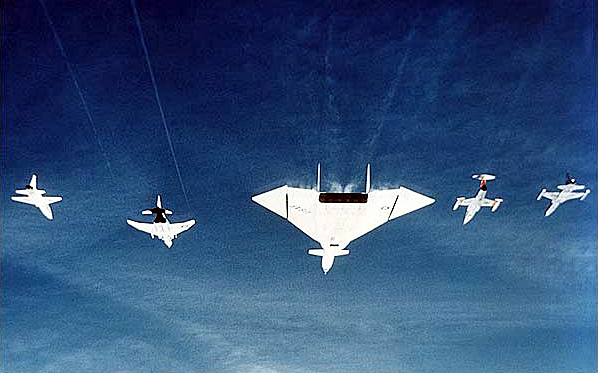
Forty-nine years ago today, XB-70A Valkyrie Air Vehicle No. 2 (62-0207) and a NASA F-104N Starfighter (N813NA) were destroyed following a midair collision near Bartsow, CA. USAF Major Carl S. Cross and NASA Chief Test Pilot Joseph A. Walker perished in the tragedy.
On Wednesday, 08 June 1966, XB-70A Valkyrie Air Vehicle No. 2 took-off from Edwards Air Force Base, California for the final time. The crew for this flight included aircraft commander and North American test pilot Alvin S. White and right-seater USAF Major Carl S. Cross. White would be making flight No. 67 in the XB-70A while Cross was making his first. For both men, this would be their final flight in the majestic Valkyrie.
In the past several months, Air Vehicle No. 2 had set speed (Mach 3.08) and altitude (74,000 feet) records for the type. But on this fateful day, the mission was a simple one; some minor flight research test points and a photo shoot.
The General Electric Company, manufacturer of the massive XB-70A’s YJ93-GE-3 turbojets, had received permission from Edwards USAF officials to photograph the XB-70A in close formation with a quartet of other aircraft powered by GE engines. The resulting photos were intended to be used for publicity.
The formation, consisting of the XB-70A, a T-38A Talon (59-1601), an F-4B Phantom II (BuNo 150993), an F-104N Starfighter (N813NA), and an F-5A Freedom Fighter (59-4898), was in position at 25,000 feet by 0845. The photographers for this event, flying in a GE-powered Gates Learjet Citation (N175FS) stationed about 600 feet to the left and slightly aft of the formation, began taking photos.
The photo session was planned to last 30 minutes, but went 10 minutes longer to 0925. Then at 0926, just as the formation aircraft were starting to leave the scene, the frantic cry of Midair! Midair Midair! came over the communications network.
Somehow, the NASA F-104N, piloted by NASA Chief Test Pilot Joe Walker, had collided with the right wing-tip of the XB-70A. Walker’s out-of-control F-104 then rolled inverted to the left and sheared-off the XB-70A’s twin vertical tails. The F-104N fuselage was severed just behind the cockpit and Walker died instantly in the terrifying process.
Curiously, the XB-70A continued on in steady, level flight for about 16 seconds despite the loss of its primary directional stability lifting surfaces. Then, as White attempted to control a roll transient, the XB-70A rapidly departed controlled flight.
As the doomed aircraft torturously pitched, yawed and rolled, its left wing structurally failed and fuel spewed furiously from its fuel tanks. White was somehow able to eject and survive. Cross never left the aircraft and rode it down to impact just north of Barstow, California.
A mishap investigation followed and (as always) blame was assigned and new procedures implemented. However, none of that changed the facts that on this, the Blackest Day at Edwards Air Force Base, American aviation lost two of its best men and aircraft in a flight mishap that was, in the final analysis, preventable.
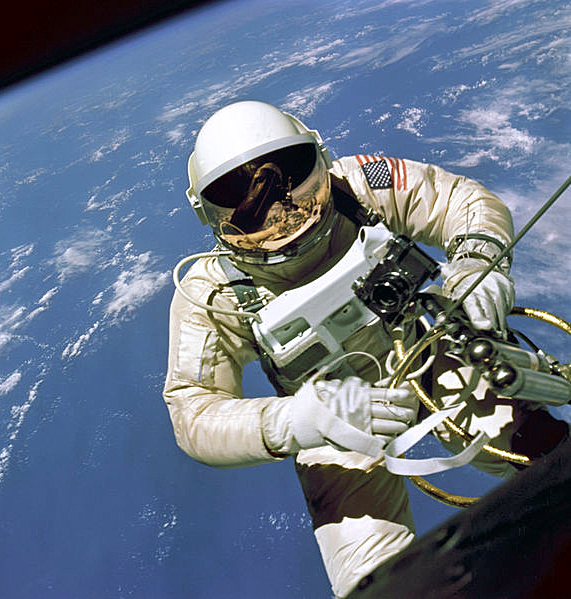
Fifty years ago today, Astronaut Edward H. White II became the first American to walk in space. Known in official NASA parlance as an Extra Vehicular Activity (EVA), White’s space feat took place during the historic 4-day mission of Gemini IV.
White, Mission Commander James A. McDivitt and their Gemini IV spacecraft were launched into low Earth orbit by a two-stage Titan II launch vehicle from LC-19 at Cape Canaveral Air Force Station, Florida. The mission clock started at 15:15:59 UTC on Thursday, 03 June 1965.
On the third orbit, less than five hours after launch, White opened the Gemini IV starboard hatch. He stood in his seat and mounted a camera to capture his historic space stroll. He then cast-off from Gemini IV and became a human satellite.
White was tethered to Gemini IV via a 15-foot umbilical that provided oxygen and communications to his EVA suit. A gold-plated visor on his helmet protected his eyes from the searing glare of the sun. The space-walking astronaut was also outfitted with a hand-held maneuvering unit that used compressed oxygen to power its small thrusters. And, like any good tourist, he also took along a camera.
Ed White had the time of his all-too-brief life in the 22 minutes that he walked in space. The sight of the earth, the spacecraft, the sun, the vastness of space, the freedom of movement all combined to make him exclaim at one point, “I feel like a million dollars!”.
Presently, it was time to get back into the spacecraft. But, couldn’t he just stay outside a little longer? NASA Mission Control and Commander McDivitt were firm. It was time to get back in; now! He grudgingly complied with the request/order, plaintively saying: “It’s the saddest moment of my life!”
As Ed White got back into his seat, he and McDivitt struggled to lock the starboard hatch. Both men were exhausted, but ebullient as they mused about the successful completion of America’s first space walk.
Gemini IV would eventually orbit the Earth 62 times before splashing-down in the Atlantic Ocean at 17:12:11 GMT on Sunday, 07 June 1965. The 4-day mission was another milestone in America’s quest for the moon.
The mission was over and yet Ed White was still a little tired. But then, that was really quite easy to understand. In the time that he was working outside the spacecraft, Gemini IV had traveled almost a third of the way around the Earth.
Now, that’s a long walk!






